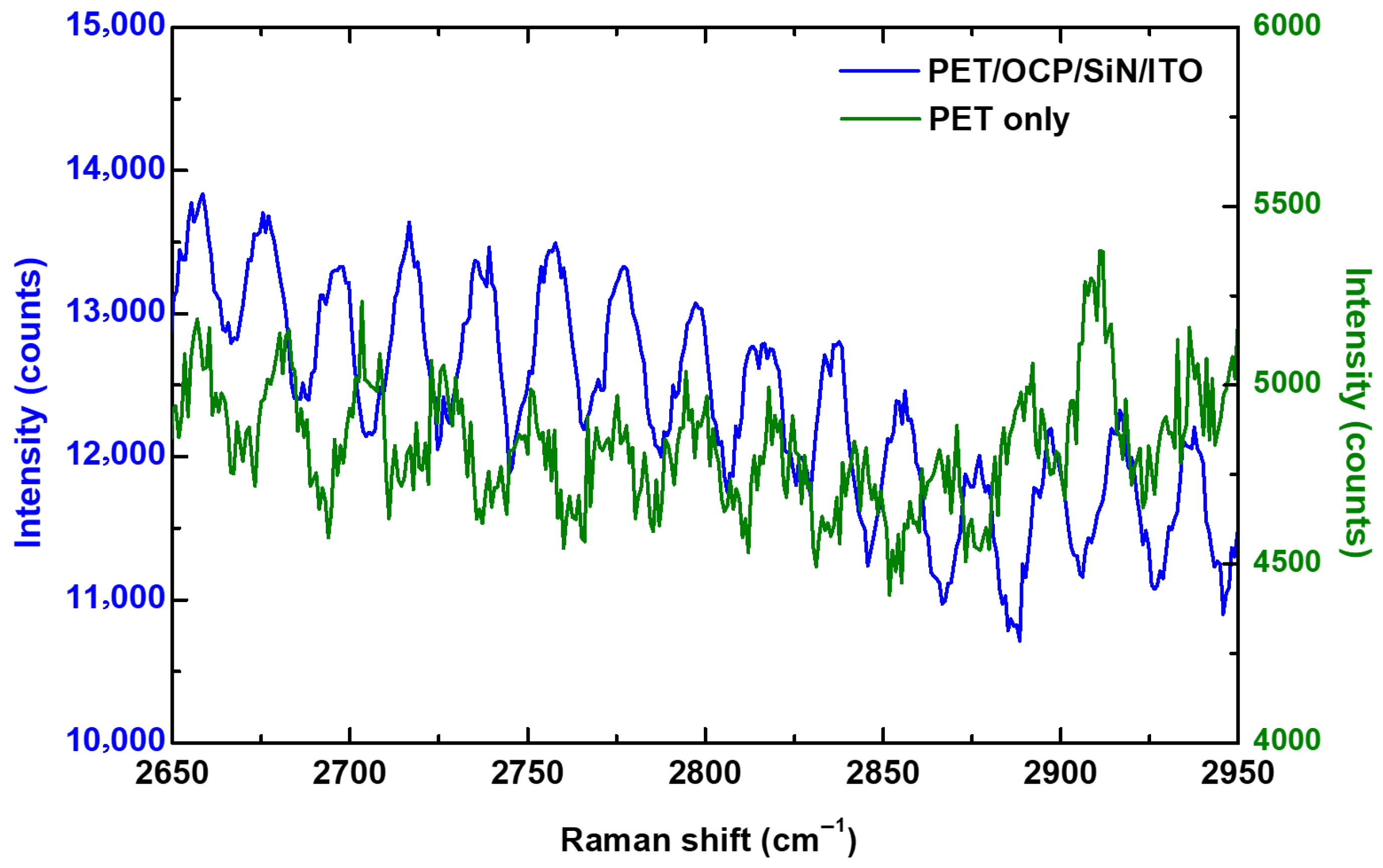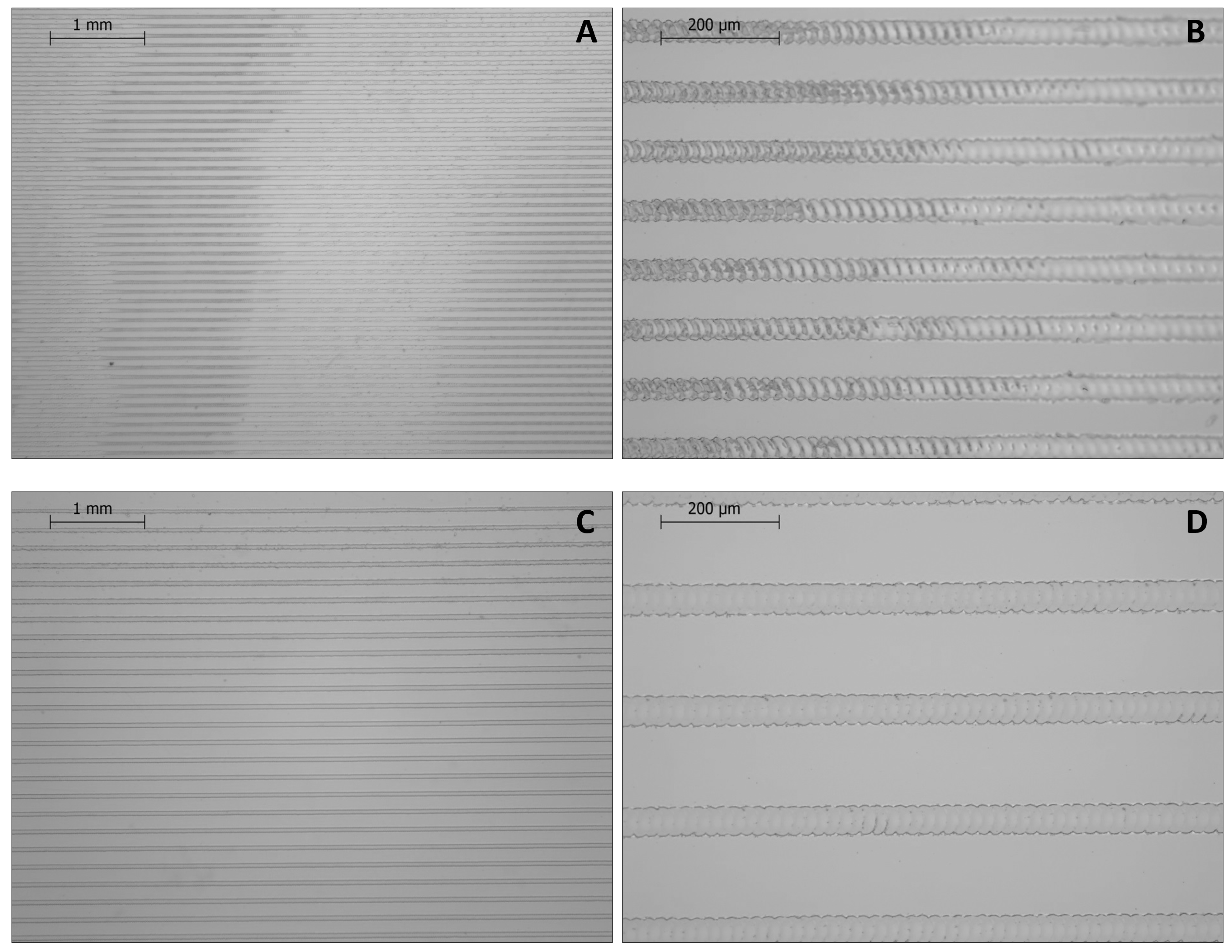Highly Selective Laser Ablation for Thin-Film Electronics: Overcoming Variations Due to Minute Optical Path Length Differences in Plastic Substrates
Abstract
1. Introduction
2. Materials and Methods
3. Results and Discussion
3.1. White Light Interferometry
3.2. Raman Spectroscopy and Principal Component Analysis
4. Conclusions
Author Contributions
Funding
Data Availability Statement
Acknowledgments
Conflicts of Interest
References
- Willmann, J.; Stocker, D.; Dörsam, E. Characteristics and evaluation criteria of substrate-based manufacturing. Is roll-to-roll the best solution for printed electronics? Org. Electron. 2014, 15, 1631–1640. [Google Scholar] [CrossRef]
- Kaltenbrunner, M.; White, M.S.; Głowacki, E.D.; Sekitani, T.; Someya, T.; Sariciftci, N.S.; Bauer, S. Ultrathin and lightweight organic solar cells with high flexibility. Nat. Commun. 2012, 3, 770. [Google Scholar] [CrossRef] [PubMed]
- Wang, F.; Yan, Y.; Mu, Q.; Zhou, P. Laser rear-side ablation mechanism for ITO removal on PET substrate. Appl. Phys. A Mater. Sci. Process. 2024, 130, 186. [Google Scholar] [CrossRef]
- MacDonald, W.A.; Looney, M.K.; MacKerron, D.; Eveson, R.; Adam, R.; Hashimoto, K.; Rakos, K. Latest advances in substrates for flexible electronics. J. Soc. Inf. Disp. 2007, 15, 1075–1083. [Google Scholar] [CrossRef]
- Lewis, J. Material challenge for flexible organic devices. Mater. Today 2006, 9, 38–45. [Google Scholar] [CrossRef]
- With, P.C.; Helmstedt, U.; Prager, L. Flexible Transparent Barrier Applications of Oxide Thin Films Prepared by Photochemical Conversion at Low Temperature and Ambient Pressure. Front. Mater. 2020, 7, 200. [Google Scholar] [CrossRef]
- Ashkenasi, D.; Rosenfeld, A. Processing multilayer systems using femtosecond, picosecond, and nanosecond laser pulses at different wavelengths. In Proceedings of the Photon Processing in Microelectronics and Photonics, San Jose, CA, USA, 27–30 January 2002. [Google Scholar] [CrossRef]
- Xiao, S.; Fernandes, S.A.; Ostendorf, A. Selective patterning of ITO on flexible PET Substrate by 1064nm picosecond Laser. Phys. Procedia 2011, 12, 125–132. [Google Scholar] [CrossRef]
- Račiukaitis, G.; Brikas, M.; Gedvilas, M.; Rakickas, T. Patterning of indium-tin oxide on glass with picosecond lasers. Appl. Surf. Sci. 2007, 253, 6570–6574. [Google Scholar] [CrossRef]
- Risch, A.; Hellmann, R. Picosecond laser patterning of ITO thin films. Phys. Procedia 2011, 12, 133–140. [Google Scholar] [CrossRef]
- Park, M.; Chon, B.H.; Kim, H.S.; Jeoung, S.C.; Kim, D.; Lee, J.I.; Chu, H.Y.; Kim, H.R. Ultrafast laser ablation of indium tin oxide thin films for organic light-emitting diode application. Opt. Lasers Eng. 2006, 44, 138–146. [Google Scholar] [CrossRef]
- Henry, M.; Harrison, P.M.; Wendland, J. Laser direct write of active thin-films on glass for industrial flat panel display manufacture. J. Laser Micro Nanoeng. 2007, 2, 49–56. [Google Scholar] [CrossRef]
- Moorhouse, C.; Karnakis, D.; Kapnopoulos, C.; Laskarakis, A.; Mekeridis, E.; Logothetidis, S. Laser patterning of smart nanomaterials for reel-to-reel production of organic photovoltaic (OPV) devices. J. Laser Micro Nanoeng. 2015, 10, 195–201. [Google Scholar] [CrossRef]
- Tseng, S.F.; Hsiao, W.T.; Huang, K.C.; Chiang, D.; Chen, M.F.; Chou, C.P. Laser scribing of indium tin oxide (ITO) thin films deposited on various substrates for touch panels. Appl. Surf. Sci. 2010, 257, 1487–1494. [Google Scholar] [CrossRef]
- Patel, R.S.; Clark, D.; Bovatsek, J. Laser scribing: A key enabling technology for manufacturing of low cost thin film photovoltaic cells. In Proceedings of the ICALEO 2007: 26th International Congress on Laser Materials Processing, Laser Microprocessing and Nanomanufacturing, Orlando, FL, USA, 29 October–1 November 2007. [Google Scholar] [CrossRef]
- Shin, Y.; Jeon, B.; Shin, S.; Lim, S.; Souk, J.; Odajima, T. 49.1: Fabrication of 23” PVA LCD Panel by Laser Ablation Process of ITO. SID Symp. Dig. Tech. Pap. 2009, 40, 727. [Google Scholar] [CrossRef]
- Ishteev, R.; Gostishchev, P.; Tiukhova, M.; Sorokin, A.; Ishteev, A.; Kondratenko, V. Technological parameters of thin-film pulsed laser scribing for perovskite photovoltaics. Clean Energy 2024, 8, 127–135. [Google Scholar] [CrossRef]
- Razza, S.; Pescetelli, S.; Agresti, A.; Di Carlo, A. Laser processing optimization for large-area perovskite solar modules. Energies 2021, 14, 1069. [Google Scholar] [CrossRef]
- Taheri, B.; De Rossi, F.; Lucarelli, G.; Castriotta, L.A.; Di Carlo, A.; Brown, T.M.; Brunetti, F. Laser-Scribing Optimization for Sprayed SnO2-Based Perovskite Solar Modules on Flexible Plastic Substrates. ACS Appl. Energy Mater. 2021, 4, 4507–4518. [Google Scholar] [CrossRef]
- Karnakis, D.; Kearsley, A.; Knowles, M. Ultrafast laser patterning of OLEDs on flexible substrate for solid-state lighting. J. Laser Micro Nanoeng. 2009, 4, 218–223. [Google Scholar] [CrossRef]
- Karnakis, D.; Stephens, T.; Chabrol, G. Maskless selective laser patterning of PEDOT:PSS on barrier/foil for organic electronics applications. In Proceedings of the Laser Applications in Microelectronic and Optoelectronic Manufacturing (LAMOM) XVIII, San Francisco, CA, USA, 4–7 February 2013. [Google Scholar] [CrossRef]
- Mandamparambil, R.; Fledderus, H.; Van Steenberge, G.; Dietzel, A. Patterning of Flexible Organic Light Emitting Diode (FOLED) stack using an ultrafast laser. Opt. Express 2010, 18, 7575–7583. [Google Scholar] [CrossRef]
- Fledderus, H.; Akkerman, H.B.; Salem, A.; Schilling, N.F.; Klotzbach, U. Patterning of organic photovoltaic on R2R processed thin film barriers using IR laser sources. In Proceedings of the SPIE-The International Society for Optical Engineering, San Francisco, CA, USA, 17 February 2017; Volume 10092. [Google Scholar] [CrossRef]
- Friedrich-Schilling, N.; Fledderus, H.; Peuckert, F.; Kuntze, T.; Gburek, B.; Salem, A.; Akkerman, H.B.; Anderson, M. Development of a Reproducible Laser Structuring Process of Stacked Thin Films on Ultra-Barrier Films for Organic Solar Devices. In Proceedings of the EU PVSEC 2017, Amsterdam, The Netherlands, 25–29 September 2017; pp. 1047–1051. [Google Scholar] [CrossRef]
- Naithani, S.; Mandamparambil, R.; Fledderus, H.; Schaubroeck, D.; Steenberge, G. Van Fabrication of a laser patterned flexible organic light-emitting diode on an optimized multilayered barrier. Appl. Opt. 2014, 53, 2638–2645. [Google Scholar] [CrossRef]
- Nisato, G.; Klumbies, H.; Fahlteich, J.; Müller-Meskamp, L.; Van De Weijer, P.; Bouten, P.; Boeffel, C.; Leunberger, D.; Graehlert, W.; Edge, S.; et al. Experimental comparison of high-performance water vapor permeation measurement methods. Org. Electron. 2014, 15, 3746–3755. [Google Scholar] [CrossRef]
- Chen, M.F.; Chen, Y.P.; Hsiao, W.T.; Gu, Z.P. Laser direct write patterning technique of indium tin oxide film. Thin Solid Films 2007, 515, 8515–8518. [Google Scholar] [CrossRef]
- Schoonderbeek, A.; Schütz, V.; Haupt, O.; Stute, U. Laser processing of thin films for photovoltaic applications. J. Laser Micro Nanoeng. 2010, 5, 248–255. [Google Scholar] [CrossRef]
- McDonnell, C.; Milne, D.; Prieto, C.; Chan, H.; Rostohar, D.; O’Connor, G.M. Laser patterning of very thin indium tin oxide thin films on PET substrates. Appl. Surf. Sci. 2015, 359, 567–575. [Google Scholar] [CrossRef]
- Birnbaum, M. Modulation of the reflectivity of semiconductors. J. Appl. Phys. 1965, 36, 657–658. [Google Scholar] [CrossRef]
- Siegrist, M.; Kaech, G.; Kneubühl, F.K. Formation of a periodic wave structure on the dry surface of a solid by TEA-CO2-laser pulses. Appl. Phys. 1973, 2, 45–46. [Google Scholar] [CrossRef]
- Van Driel, H.M.; Sipe, J.E.; Young, J.F. Laser-induced periodic surface structure on solids: A universal phenomenon. Phys. Rev. Lett. 1982, 49, 1955–1958. [Google Scholar] [CrossRef]
- Sipe, J.E.; Young, J.F.; Preston, J.S.; Van Driel, H.M. Laser-induced periodic surface structure. I. Theory. Phys. Rev. B 1983, 27, 1141–1154. [Google Scholar] [CrossRef]
- Young, J.F.; Preston, J.S.; Van Driel, H.M.; Sipe, J.E. Laser-induced periodic surface structure. II. Experiments on Ge, Si, Al, and brass. Phys. Rev. B 1983, 27, 1155–1172. [Google Scholar] [CrossRef]
- Young, J.F.; Sipe, J.E.; Van Driel, H.M. Laser-induced periodic surface structure. III. Fluence regimes, the role of feedback, and details of the induced topography in germanium. Phys. Rev. B 1984, 30, 2001–2015. [Google Scholar] [CrossRef]
- Wagner, F.R. Scanning excimer laser ablation of poly(ethylene terephthalate) (PET) and its application to rapid prototyping of channels for microfluidics. Eng. Mater. Sci. 2000, 2264. [Google Scholar] [CrossRef]
- Li, X.; Yang, T.; Li, S.; Wang, D.; Song, Y.; Zhang, S. Raman spectroscopy combined with principal component analysis and k nearest neighbour analysis for non-invasive detection of colon cancer. Laser Phys. 2016, 26, 035702. [Google Scholar] [CrossRef]
- Serkov, A.A.; Snelling, H.V.; Heusing, S.; Amaral, T.M. Laser sintering of gravure printed indium tin oxide films on polyethylene terephthalate for flexible electronics. Sci. Rep. 2019, 9, 1773. [Google Scholar] [CrossRef]







| Layer | Thickness (nm) | Refractive Index |
|---|---|---|
| PET | 125 × 103 | 1.58 |
| OCP | 22.3 × 103 | 1.50 |
| SiN | 150 | 1.80 |
| ITO | 135 | 1.93 |
Disclaimer/Publisher’s Note: The statements, opinions and data contained in all publications are solely those of the individual author(s) and contributor(s) and not of MDPI and/or the editor(s). MDPI and/or the editor(s) disclaim responsibility for any injury to people or property resulting from any ideas, methods, instructions or products referred to in the content. |
© 2025 by the authors. Licensee MDPI, Basel, Switzerland. This article is an open access article distributed under the terms and conditions of the Creative Commons Attribution (CC BY) license (https://creativecommons.org/licenses/by/4.0/).
Share and Cite
Fawzy, A.; Fledderus, H.; Shen, J.; Manders, W.H.; Verstegen, E.; Akkerman, H.B. Highly Selective Laser Ablation for Thin-Film Electronics: Overcoming Variations Due to Minute Optical Path Length Differences in Plastic Substrates. J. Exp. Theor. Anal. 2025, 3, 38. https://doi.org/10.3390/jeta3040038
Fawzy A, Fledderus H, Shen J, Manders WH, Verstegen E, Akkerman HB. Highly Selective Laser Ablation for Thin-Film Electronics: Overcoming Variations Due to Minute Optical Path Length Differences in Plastic Substrates. Journal of Experimental and Theoretical Analyses. 2025; 3(4):38. https://doi.org/10.3390/jeta3040038
Chicago/Turabian StyleFawzy, Ahmed, Henri Fledderus, Jie Shen, Wiel H. Manders, Emile Verstegen, and Hylke B. Akkerman. 2025. "Highly Selective Laser Ablation for Thin-Film Electronics: Overcoming Variations Due to Minute Optical Path Length Differences in Plastic Substrates" Journal of Experimental and Theoretical Analyses 3, no. 4: 38. https://doi.org/10.3390/jeta3040038
APA StyleFawzy, A., Fledderus, H., Shen, J., Manders, W. H., Verstegen, E., & Akkerman, H. B. (2025). Highly Selective Laser Ablation for Thin-Film Electronics: Overcoming Variations Due to Minute Optical Path Length Differences in Plastic Substrates. Journal of Experimental and Theoretical Analyses, 3(4), 38. https://doi.org/10.3390/jeta3040038






